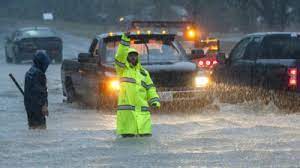
Heavy rainfall has flooded parts of Massachusetts and Rhode Island, with one city declaring a state of emergency as water poured into homes, creating moats around their foundations, and stranded drivers. Concern about a dam listed in poor condition led to evacuations.
More storms were in the forecast for Wednesday, and although it was still early, winds and flooding from Hurricane Lee were expected to affect Rhode Island, eastern Massachusetts, southeastern New Hampshire and central and coastal Maine during the weekend, forecasters said.
Mayor Dean Mazzarella in Leominster, about 40 miles (64 kilometers) northwest of Boston, urged people not to venture outside as roads flooded Monday night, but some residents were evacuated as water came into their basements. All schools were closed Tuesday and two shelters were set up.
“The storm stopped over us last night. It didn’t move for close to five hours. It had dumped 11 inches (28 centimeters) of rain,” Mazzarella said at a news conference Tuesday morning. The National Weather Service had not immediately confirmed that figure.
On Monday night, in a recording posted online, Mazzarella had urged people to “Find a high spot somewhere. Find a high spot and stay there until this is over.”
He said if there were any injuries they were minor.
Steve Forcier, 62, said he was half asleep watching television in his mobile home when firefighters knocked on his door late Monday night.
“It was a little intimidating, a little frightening,” he said Tuesday morning outside the school where he and others spent the night. “When I looked out there, I said, ‘Holy crap!’”
The water outside was about waist-high, Forcier said, but he had minimal damage to his home when he evacuated. Firefighters used inflatable rafts to bring residents of the mobile home park to trucks and buses.
“It’s been a very emotional roller coaster for many,” Leominster Schools Superintendent Paul Deacon said outside the shelter, where at least 80 people had stayed overnight. “They don’t know what happened to their homes, many of them left with nothing, so they’re anxious to get back to see the conditions of where they live, talk to people they care about,” she said.
Deacon said she’s never experienced that type of emergency response and came away impressed.
“There were so many people here with open arms to help navigate. We just all jumped in and started taking care of one another, and that’s a tribute to this community.”
Early Tuesday, the city said people living in areas near a brook and the North Nashua River in Leominster should “immediately evacuate” as a precaution, “due to a potential issue at the Barrett Park Pond Dam.”
“This particular dam is one that we’re actually about to replace, and it is very sensitive. It is water-saturated and we worry about that downstream,” Mazzarella said at the news conference.
The dam is a 15-foot-tall (4.5-meter-tall) earthen structure listed in poor condition and posing a significant hazard, meaning its failure could result in economic damages, but would not be expected to cause loss of life, according to the U.S. Army Corps of Engineers’ National Inventory of Dams. The database shows it was last inspected in November 2017, though it’s supposed to be inspected every five years.
Mazzarella said there were at least several homes in Leominser where “the water washed out around them” and the foundations could be seen.
Massachusetts Gov. Maura Healey said earlier that emergency boat rescue and response teams were in the city.
“My heart goes out to residents and public safety officials in Leominster and other communities experiencing catastrophic flooding tonight,” she posted on X, the platform formerly known as Twitter.
Other communities also experienced flooding. In North Attleborough, Massachusetts, about 55 miles (88.5 kilometers) south of Leominster, the town said in a statement that crews worked to clear water from roads Monday night and about 200 homes had flood damage.
Little rain was expected Tuesday, but storms are expected to hit the area Wednesday afternoon and evening, and some could produce heavy rain, the National Weather Service said.
New England has experienced its share of flooding this summer, including a storm that dumped up to two months of rain in two days in Vermont, resulting in two deaths.
Atmospheric scientists say floods occurring in different parts of the world are fueled by climate change, with storms forming in a warmer atmosphere, making extreme rainfall more frequent. The additional warming scientists predict is coming will only make it worse.
___
Associated Press writers Kathy McCormack and Holly Ramer in New Hampshire, David Sharp in Maine, Lisa Rathke in Vermont, and David Lieb in Missouri contributed to this report.




